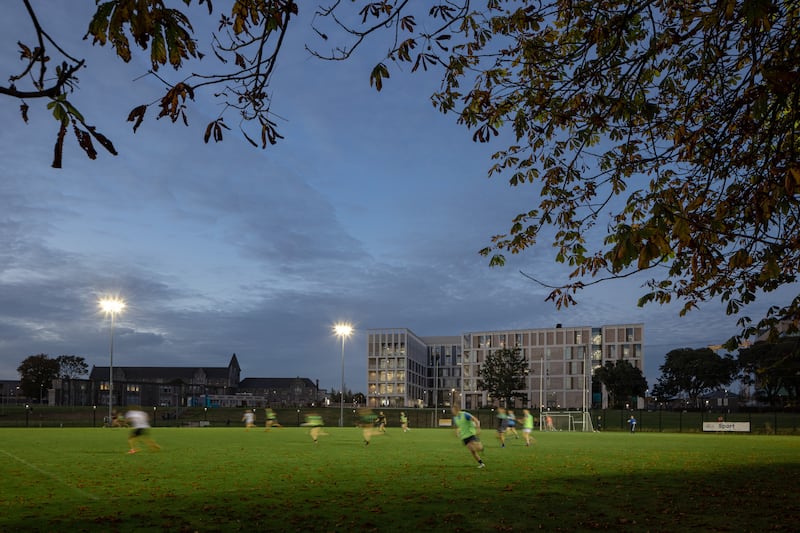For two centuries Grangegorman was a place to avoid. The old mental asylum, which housed up to 2,000 patients behind high walls, was cut off from the rest of society.
Today, a new urban quarter is taking shape in Dublin’s north inner city which is home to the second-biggest university in the State.
Technological University Dublin’s campus hosts more than 10,000 students representing a range of disciplines in the arts, humanities, science, technology and engineering.
It is just a third of the way through its development plans, but it is quickly taking shape.
Inside the new East Quad building, the university’s new cultural hub, strains of music float up from the recital rooms. There is a 400-seat concert hall, theatre space, art studio and suite of classrooms, workshops and exhibition areas with graduates projects on display.
The president of TU Dublin, Prof David FitzPatrick, says the campus is forging new connections for staff and students who until recently were scattered across the city.
[ TU Dublin: One of Ireland’s largest providers of higher educationOpens in new window ]
[ Can a TU advance my career like a traditional university can?Opens in new window ]
“Staff are actually meeting staff that they have never met before, even though they may have worked for the same organisation for 30 years or more,” he says.
The decision by Workday, a US software company, to create its new European headquarters adjacent to the university – creating 1,000 jobs – is also seen as a vote of confidence.
“Industry and university partnerships have many difference guises – it gives them, and us, big opportunities,” he says.

The university has been selling off its former DIT buildings across the city – Kevin Street, Cathal Brugha Street, Rathmines – and using the funds to build new facilities in Grangegorman.
However, there is fresh uncertainty over the next phase of development.
High construction costs mean there is a gap in funding to build a new West Quad for business students, as well as indoor sports facilities and student accommodation.
Technological universities – formerly institutes of technology – have been statutorily barred from borrowing money in the past.
Prof Fitzgerald says the university is in talks with the Government over changing this.
“We’ll be working with the Department [of Higher Education] around how we can do that. I hope we can get a model in place. Otherwise we don’t have any way of doing it,” he says.
The accommodation crisis for students has been well-documented. One troubling development, he says, is signs that more students are opting to commute long distances.
TU Dublin’s plans to create “hundreds” of new beds won’t solve the problem, but he hopes the Government will part-fund them to ensure they are kept at affordable rates for students.
In addition, there is a growing number of privately built student accommodation options close by.
[ Why study at a TU?Opens in new window ]
Long commutes don’t sit well with the college’s new emphasis on sustainability. All its first-year students from this September will have modules on sustainability as part of their induction, while it will be part of the core curriculum across all courses the following year.
It is, he says, aimed at allowing students to look beyond the confines of their study and to “grow and develop”.
A large number of Leaving Cert students in exam halls this week, meanwhile, will be joining the university soon.
Prof FitzPatrick doesn’t have much truck with the notion that too many school-leavers are heading to university.
However, he does agree that a pressure-cooker Leaving Cert and CAO points system is not the best entry route for all.
In some cases, he says, it leads to students going into courses that are “not the best thing for them”.

“If you have somebody who gets 625 points in the Leaving Cert and they say they want to go and do something with a much lower points requirements, there’s almost a societal pressure over ‘wasting’ points. That’s just not right,” he says.
One of the reasons for this, he says, is that other pathways to college are not easily understood or transparent enough.
He wants to change this by expanding options for students entering college outside the CAO system through, for example, post-Leaving Cert courses or apprenticeships.
“We have students who come through those routes, for sure, but they’re relatively small. Our new educational model, the primary intent of it, is to make progression pathways more easily understood and more accessible… It’s not something we can change overnight, because people have developed a way of thinking and looking at it.”
Once students are enrolled, he says, there are plans to make it much easier to combine elements of different courses which reflect the full breadth of the university.
An example, he says, is a journalism student who opts to focus on computing or data; or an engineering student who wants to try something on the creative side in arts and humanities.
“Very few students know exactly what they want to do when they go into university. Some do; the vast majority, don’t. They have an interest in something. So, [the question is] how do you best facilitate that?”
[ ‘Much tougher than recent years’: Reaction to today’s Leaving Cert examsOpens in new window ]
While it sounds positive in theory, it will take time to change.
“We’ll start introducing changes from 2025 and it will accelerate from there. It’s starting to happen… but we can’t make a step-change in CAO, as there is a two-year lead time.”
He is also convinced that more pathways into college could help reduce student dropout rates.
“Retention across tertiary [further and higher] education is patchy. And in some cases is really bad, frankly. We want to try and reduce that and improve the retention figures. One way you do that is by providing a pathway that lets people come in and out at difference paces,” he says.
Prof FitzPatrick adds that the university – and wider higher education – needs to do more to fully embrace lifelong learning.
“The idea that there’s a four-year window that you’re going to learn everything and come out with a qualification – that’s clearly long gone… but we still have that very strong mindset.
“Offering flexibility, offering choice and offering breadth of opportunity, is really where we want to get to. To take away the sense that this is a one-hit thing.”
The idea of a voucher system for employees to avail of upskilling – proposed by employers’ group Ibec – is one novel approach.
With five new technological universities in recent years, the higher education landscape suddenly seems very crowded. Is there a danger we have too many institutions doing the same thing?
He says a key differentiator for technological universities is that they cover “everything from apprenticeships right through to PhDs”.
In addition, he sees TUs developing their close links with industry to develop stronger research collaboration.
“We have the potential to have a huge impact, not just on students and what they learn within the system, but actually as an economic driver,” he says.
Over the last few years, he says, TU Dublin has produced over 400 new businesses with an economic impact of €700 million.
“We’d like to do more,” he says.
At the same time, he says the university is proud that it is giving opportunities to people of all socioeconomic backgrounds.
Many students from immigrant families attending its Blanchardstown and Tallaght campuses, in particular, are often the first in their family to get a college degree.
“It is particularly noticeable in some of the conferring ceremonies – it’s a very mixed and modern community. That diversity is really reflected in the noise, excitement and passion that people show.
“It’s definitely not a traditional university conferring where it’s all very formal. That’s great for us. We’re clearly doing something that is of direct value to the student, but actually has a huge impact on their family and friends.”











